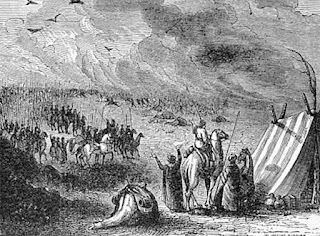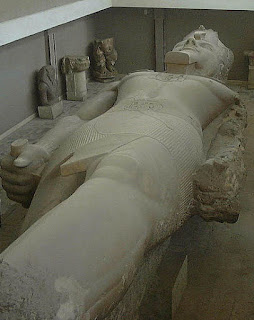My intentions in writing this article are only meant as an interpretation of the royal necropolis with a number of the tombs mentioned we will probably never know anything about. It appears the early kings of dynasty 18 used the new cemetery to keep their most important courtiers buried close to their king.
These courtier tombs may have inspired little respect from succeeding kings and their courts as the importance of the Valley of the Kings grew. Many of these earlier courtiers may have been removed from the valley and placed into tombs in the other Theban cemeteries even before the dynasty had ended.
The famous biography in the tomb of Ineni says's he was responsible for creating the tomb of Thutmosis I, "no one seeing and no one hearing". Archaeologists have long looked and speculated on the whereabouts of this tomb.
There are two tombs which bore sarcophagus's for this king, the first a small poorly cut tomb in the Valley of the King's tomb (KV 38) has been shown to be a reburial of the king during the reign of his grandson Thutmosis III.
The second a joint tomb with his daughter Hatshepsut (KV 20) seems more likely to be Ineni's work however with all the activities by Hatshepsut's workers in the tomb. Would you just push the king and his coffins aside so the workers could continue finishing the tomb for the female king,
I would doubt this but might actually place the original burial in the nearby neighboring tomb known today as KV 60. The year is 1492 BC the short reign of Thutmosis I, is over and the founder of his dynasty is perhaps placed into the tomb his architect Ineni had created in an unused wadi.
So begins the history of what would become one of the most famous royal necropolis in the world. The Valley of the Kings. The tomb carved by Ineni's workers (KV 60) would seem like a less than grand start to the new royal necropolis perhaps inspiring his daughter to create a grander monument for herself and her father.
Hatshepsut's valley tomb (KV 20) is a wonky corkscrew tomb that is hardly little more than an extremely long cave free from the mathematics of engineering but also flawed by the lowest chambers being carved in unstable shale.
The next known pharaohs tomb in the valley is that of Thutmosis III, and his family representing a renaissance for the tomb builders. The layouts of tombs KV 33,34, 38 and 42 present the viewer with ever refining geometry while the reburial of Thutmosis I, tomb KV 38 appears to be the earliest of the group.
We find in tomb 34's cartouche shaped burial chamber the first truly beautiful room in the valley with its pink decoration the Imyduat inscribed on its walls scrolled out like a giant roll of papyrus surrounding the king's quartzite sarcophagus regarded as one of the most beautiful of its kind in Egyptian history.
A deeply carved well was the first in the valley and an exclusive to future kings tombs. Tomb 42 was started for Thutmosis III's great royal wife Hatshepsut Meryet Re though not on the scale of her husband's tomb the mathematics is just that more precise. The tomb also like KV 34 and KV 38 has a cartouche shaped burial chamber, an exclusive to this kings family.
Nearby tombs numbered KV 26 and KV 37 are small unrefined cuttings which may belong to this series of tombs as do probably cuttings KV 33 by location and F by a foundation deposit.
From the crude reburial of Thutmosis I, to the more refined tombs of Thutmosis III and his queen a true renaissance had occurred bringing forth the golden age of the Necropolis.
Starting in the reign of Thutmosis's son Amenhotep II, the cartouche shaped burial chamber is abandoned and replaced with a six-pillared hall with lower crypt. The well has been retained as has the decoration of the Imyduat scroll in the burial chamber.
The geometrics of the tomb are well executed and the tombs fine preservation make this perhaps the finest surviving tomb of an 18th Dynasty king.
Near to this king's tomb is another numbered KV 48, in this crude cutting was found the broken mummy of Amenhotep's vizier Amenimopet. Surrounding the vizier's tomb are three small tombs which when found contained animal mummies which may have been pets or sacred to Amenhotep II.
The enigmatic tomb KV 12 may have been started as a family tomb for this king. A lesser queen of Amenhotep's named Tiaa and mother of his heir Thutmosis IV, was probably buried in a modest unfinished tomb numbered KV 32.
When discovered in 1899 valley tomb number KV 36 still contained much of its 18th Dynasty burial equipment including the well-preserved mummy of its owner. Maihirpre who bore the titles" Child of the nursery and fan bearer on the right of the king" died young probably in his early twenties. A vase from the tomb stylistically loosely places the date of burial at Amenhotep II or Thutmosis IV.
Thutmosis IV"s tomb mirrors his father only on a larger scale and missing the Imyduat scroll in the burial chamber. In the nearby finely carved tomb KV 21 there are two now torn apart female mummies.
Tombs numbered KV 2 7, 28 and 45 (Userhat) all contained ceramics datable to this reign or Thutmosis' successor Amenhotep III. By location tomb, KV 44 may also belong to this series.
There are two securely dated tombs in the valley for the reign of Amenhotep III, including his beautiful tomb WV 22 in the west valley. The tombs plans follow his predecessor's tombs but much more finely painted and with the addition of two extra burial suites for two of his wives including Queen Tiye.
Sadly vandalism and salt leeching into the walls have left the decoration of the tomb in poor condition, of the 24 sides of the six pillars in the crypt, only one remains relatively undamaged.
When discovered in 1905 tomb KV 46 held the sumptuous burial of Yuya and Thuya, the parents and of Amenhotep's Great royal wife Tiye.
Their undecorated tomb unusually for the valley is entered by two staircases and a corridor as opposed to a simple shaft. The cutting today known as "A" contained goods bearing this king's name. Tomb KV 55 also contained objects for this king and his queen Tiye.
The nearby location of tomb KV 62 may also belong to this group. Tomb KV 25 may well have been started for Amenhotep IV, but his revolution left the valley for the royal tomb at Akhetaten. With the return to the Valley of the King's after the Amarna period tomb, KV 55 may have been used for the reburial of Akhenaten, Smenkare and possibly Queen Tiye.
It has been suggested that Smenkare may have been buried in the tomb across the path known today as number KV 62. With king Tutankhamen's return to the valley for his burial tomb, KV 23 may have been started for him. With the unexpected death of Tutankhamen his tomb and much of his furnishings may not have been finished.
His elderly successor Aye may have appropriated the king's tomb and unfinished funerary furniture for his own death a couple of years later. Looking at the burial of Smenkare king Aye may have ordered it opened and the offending pharaoh removed to the unwanted storeroom (KV 55) across the path. If Akhenaten was in tomb KV 55 at this point he may have been removed and the heretics burial rifled leaving Smenkare with the rubbish.
The remodeling of Smenkare's burial for king Tut would require Smenkare's name to be removed from the various objects in the burial. When found by Howard Carter the tomb contained about half the jewelry the boxes said was originally in them.
This has long been thought of as the work of tomb robbers but might actually represent the number of pieces of jewelry who's inscriptions could not be altered and thus were removed from the new king's burial.
Whatever is going on a further cutting in the valley numbered KV 54 was filled with king Tut's mummification residue. Almost certainly the shaft tomb KV 63 was sealed by the time king Tutankhamun was buried.
Four years later the old king Aye was buried in the west valley in the tomb now known as KV 23. Tombs KV 58 and KV 24 may well belong to this group.
The location of tomb 49 suggests that it belongs to the next king Horemheb's time and may have been a storeroom while the king's tomb was being built. As the last king of Egypt's glorious 18th Dynasty his tomb KV 57 made a number of innovations including the first fully cut kings tomb on a straight axis in the valley.
Though his reign was long enough to have finished his tomb it remains for the most part only partially decorated. Horemheb's tomb is the first in the valley to possess passages from "The Book of Gates".
There are probably countless interpretations of the Valley of the Kings and in particularly to the family of kings and courtiers who were laid to rest there at the beginning of the New Kingdom.





 This article is on the Rosetta stone and Egypt's Secretary general of the Supreme Council of Antiquities desire to have it back not as a loan but permanent. In recent weeks Dr. Zahi Hawass has become less diplomatic with not only the British Museum but also Berlin's Neues Museum over a bust of an Amarna queen and the MuseLouvre over frescoes now returned, though Dr. Hawass still expects the Louvre to give back to Egypt the Denderah Zodiac.
This article is on the Rosetta stone and Egypt's Secretary general of the Supreme Council of Antiquities desire to have it back not as a loan but permanent. In recent weeks Dr. Zahi Hawass has become less diplomatic with not only the British Museum but also Berlin's Neues Museum over a bust of an Amarna queen and the MuseLouvre over frescoes now returned, though Dr. Hawass still expects the Louvre to give back to Egypt the Denderah Zodiac.


 Since 1987 the ministry of culture has been headed by an abstract painter Mr. Farouk Hosny who recently had been a candidate for the job of UNESCO director general. A job he lost most likely over remarks he made in 2008 in the Egyptian parliament where he threatened "I'd burn Israeli books myself if I found any in libraries in Egypt".
Since 1987 the ministry of culture has been headed by an abstract painter Mr. Farouk Hosny who recently had been a candidate for the job of UNESCO director general. A job he lost most likely over remarks he made in 2008 in the Egyptian parliament where he threatened "I'd burn Israeli books myself if I found any in libraries in Egypt". I recently purchased an old book and found inside a 50-year-old postcard from Luxor with a picture of none other than the Berlin Nefertiti and wow here I am writing yet another piece on her.
I recently purchased an old book and found inside a 50-year-old postcard from Luxor with a picture of none other than the Berlin Nefertiti and wow here I am writing yet another piece on her.


